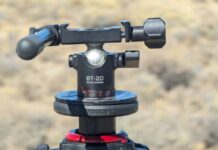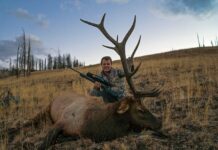While I like reading independent gear reviews, I also like to hear directly from the top manufacturers on the technical side of gear. After all, they are the experts. You’ve met Kurt Racicot of Stone Glacier on the Rok Blog before. He’s back and this time helping Rokslider’s choose backpack size. Hit it, Kurt!
Backpack Size Selection
One of the most common questions I get regarding Stone Glacier backpacks is bag size. Specifically, is the Stone Glacier Solo big enough for 5-10 day trips? The short answer is…it depends on your gear list and hunting style.
When deciding on a pack size, the first step is to get an accurate volume measurement of your gear. This can be done using the dimensions of your current pack, or any cylinder-shaped bag that you can cross reference dimensions. Organization of gear inside the bag will vary the overall volume. I suggest loading your gear a few different times in different configurations to get the least volume.
While manufactures use complicated methods to calculate volume, I recommend a simpler three-step method:
1) Measure the height of your loaded pack or representative bag in inches
2) Measure the width of the front, back, and two sides. Add these together and divide the sum by 6.28 to get the radius
*As many packs are tapered from top to bottom, it is easiest to estimate the average circumference, which in many cases is the mid-height on the pack.
3) Plug the height and radius into the formula for Volume
Volume = height x 3.14 x radius squared
This is the equation to calculate volume of a cylinder and is the base formula I use for Stone Glacier packs. I think it is the most accurate way for the customer to calculate the volume of their gear when shopping for a pack.
The last consideration is how much meat you prefer to carry with your gear load and how you will pack it. The Stone Glacier platform is designed around using the load shelf, vertically, compressing the meat between the frame and bag. Full volume in the load shelf with a loaded pack bag will equal about 80 pounds of boned meat. If the pack bag is not completely full, this can be considerably more. This could put the total load well over 100 pounds depending on gear poundage. If you prefer to load the meat inside the pack bag (6000+ cubic inch bags), then this volume has to be taken into account with your gear. Placement should be planned to minimize extra leverage which adds perceived weight on hips and shoulders; see
Stone Glacier: Understanding the Physics of Pack Load
The Stone Glacier 3300 cubic inch Solo bag is designed for the minimalist whose goal is to cover as much country as possible and come out in one trip with the entire boned animal, such as a sheep, goat, or mule deer. For me, this platform effectively doubled my range in technical Alaskan sheep country compared to making two trips in the same amount of time. In order to do this, I have to keep my overall weight around 115 pounds on the pack-out. This puts gear and pack in the 35 to 40 pound range for the trip in.
Regardless of the style or manufacturer of pack, calculating the volume you need for your gear and matching it to the correct pack size is a necessity. We all have different hunting styles and no two gear lists are the same. The key is matching your style and gear with a pack platform that will perform best for you.
Best of luck this fall.
Kurt Racicot, Stone Glacier.
For more information on the Solo, visit Stone Glacier



















Robby,
Great guest post (both this one and the one at the link about how to load your pack), but we should clarify something for those who are not familiar with packs and the various forces that act on them (from a physics perspective). Just above the link in his post, Kurt said, “Placement (sic, of the meat) should be planned to minimize extra leverage [b][u]which adds weight;[/u][/b]”.Everyone should realize that where you put your heaviest stuff does not increase or decrease the overall weight of the pack, only the “weight” or force you feel on your shoulders or hips. The added weight he is talking about is the force on your shoulders that comes from having the center of gravity of the pack farther away from your body than it needs to be.
Yes Larry, thanks for clarifying. I was the one who wrote the “adds weight” comment. Check out the blog post now, I think it’s fixed.
thanks for the post on how to get the best pack for the person and the type of hunting that they do. Also thanks to kurt at stone glacier for all of his knowledge and sharing it with all of us.
Comments are closed.